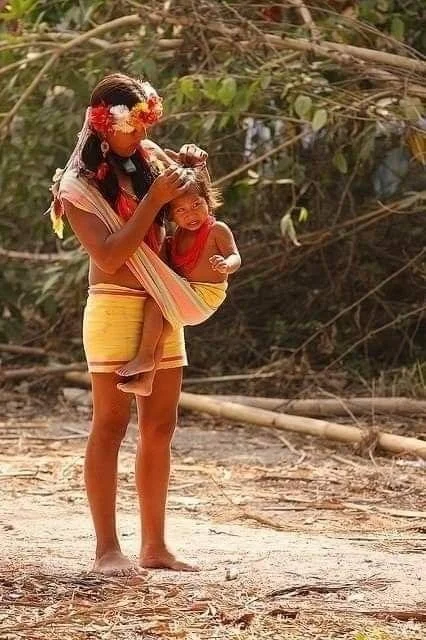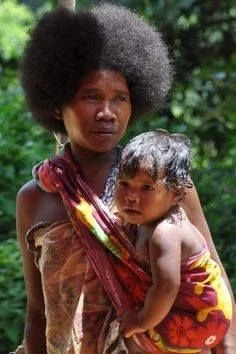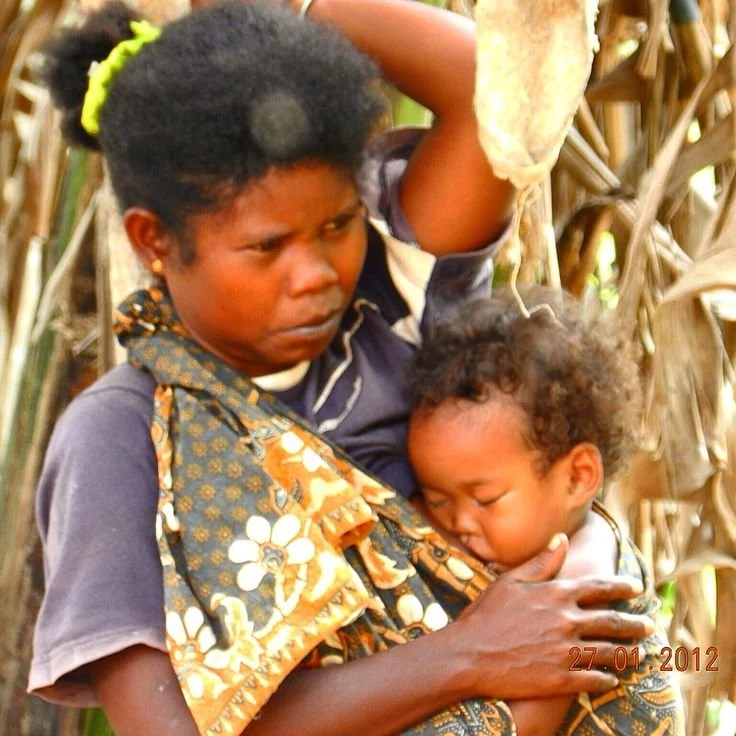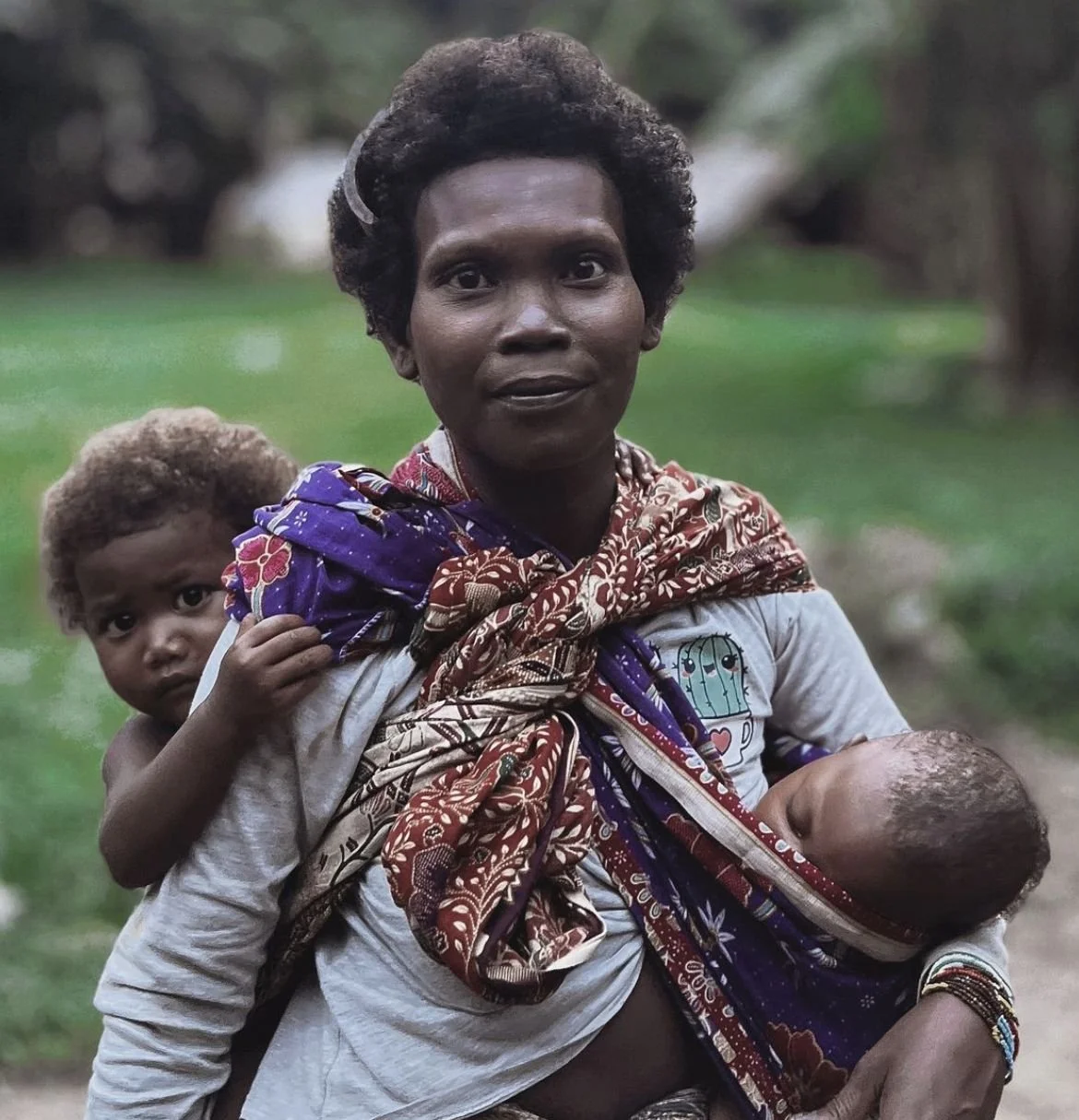Polynesian, Micronesian, and Melanesian Communities: Carried in Rhythm, Rooted in Kinship
Across the islands of the Pacific, family life has always been rich with song, story, and close connection. Babies are carried, of course — in arms, on hips, and always within reach of aunties, siblings, cousins, and community. But when we searched for images of traditional baby carriers from across Polynesia, Micronesia, and Melanesia (outside of Papua New Guinea), we were met with near-silence.
A Melanesian mother smiles warmly as her baby rests contentedly against her back, held close by a boldly patterned wrap. The cloth — likely a lava-lava or island sarong — is drawn snugly around the baby’s body and tied at the front, creating a secure and upright back carry. The baby’s arms are relaxed and the legs are spread naturally around the mother’s torso, showing a deep sense of comfort and familiarity. This form of babywearing is instinctively practiced across Melanesian communities such as those in Vanuatu, the Solomon Islands, and Papua New Guinea. The mother’s ease and the baby’s calm presence reflect a caregiving rhythm shaped by generations: hands-free, heart-close, and woven into daily life. Behind them, the thatched roofing and rural setting provide a glimpse into a village environment where babies are carried as part of the flow of work, community, and kinship.
A woman stands barefoot on dry ground, adjusting a flower crown on her head as her child rests against her hip, nestled in a woven cloth. The child is supported by a soft, striped wrap that extends from the mother’s shoulder across her back and around her waist, forming a secure sling-style carry. The fabric supports the child in a seated squat position, with legs draped naturally around the caregiver’s body. The colours of the cloth — reds, yellows, and earth tones — echo the hues of the land, the sun, and the woven traditions of the Pacific. The woman’s floral adornment, wrap style, and setting suggest a Polynesian context, likely from Tahiti or the Marquesas Islands, where cloth wraps and pareu (sarongs) are used instinctively in daily life.
The baby’s ease and the caregiver’s unhurried poise speak to a lifestyle where children are carried not as a chore but as part of the rhythm of the day — part of movement, conversation, and community. Even while attending to her own grooming, this mother holds her child close and secure, showing how care and culture intertwine.
A mother gazes into the distance, standing tall and strong, with her child cradled closely in a vibrant floral wrap. The baby is carried on her front in a traditional torso-style sling made from colourful cloth, knotted over one shoulder. The wrap supports the child’s body snugly in a seated position, with the legs draped around the mother’s waist — close enough to feel her warmth, her rhythm, and her steady breath. The mother’s natural hair and sarong-style clothing reflect the beauty and strength of Melanesian identity.
Surrounded by lush green vegetation, the setting hints at a village or forest edge in Papua New Guinea or the Solomon Islands — where babywearing continues as part of daily life, instinctively woven into the way families move, work, and care. The cloth itself is likely a multipurpose lava-lava or sarong, pressed into service not just as a garment but as a tool of connection and caregiving. Here, nothing is separate: caregiving, culture, and community are held in the same cloth.
A mother draws her baby close, supporting a deeply sleeping child with one hand while the other adjusts a patterned cloth wrap across her shoulder. The child is held snugly in a front carry, with the fabric forming a gathered sling that supports the baby’s torso and head against the caregiver’s chest. The richly coloured floral cloth — possibly a sarong or lava-lava — is tied over the shoulder and under the opposite arm, forming a supportive pouch-style carry that keeps the baby secure. The mother’s gaze is steady, her expression focused, as she tends to her child with instinctive care.
This image likely comes from Papua New Guinea or another part of Melanesia, where cloth wraps are used daily by mothers, aunties, and grandmothers alike. The date stamp and earthy backdrop suggest a rural setting, possibly among garden crops or bushland, where babies are carried as mothers go about their tasks. In these communities, babywearing is not a separate activity — it is part of how children grow, resting heart-to-heart with their caregiver while absorbing the rhythms of daily life.
A mother stands with quiet power, wrapped in richly patterned cloth, carrying both her children with confidence and grace. Her younger child rests at the breast in a front carry, cocooned in a boldly coloured batik-style wrap tied snugly over one shoulder and under the opposite arm. The baby is latched comfortably, the fabric forming a deep, secure seat and supporting the baby’s body close to the mother’s chest. Behind her, a slightly older sibling peeks out over her shoulder, arms draped gently forward, held safely in place by another layer of cloth. This tandem carry — with one child on the front and one on the back — reflects the practical wisdom and rhythm of caregiving woven into everyday life in rural Melanesian communities.
Where are the photos?
This absence doesn’t reflect a lack of love or connection. These are cultures shaped by ocean journeys, oral traditions, and collective care. Babies have long been part of every aspect of life — cradled during dances, comforted during feasts, and soothed under stars. But when it comes to structured baby carriers — slings, cloth wraps, cradleboards, bags — the evidence is hard to find.
We have a dedicated page celebrating the woven bilums of Papua New Guinea, and another focused on Māori babywearing in Aotearoa. We also know that Rayner Garner, the inventor of the modern ring sling, was first inspired by seeing babies carried close in Hawai‘i during the 1970s and ’80s. But outside of these moments and regions, we’ve struggled to find historical photographs, ethnographic records, or even oral histories that clearly describe babywearing as a widespread practice across the broader Pacific Islands.
Of course, absence in the record doesn’t mean it never happened. Colonisation, forced conversions, climate migration, and cultural disruption have all played a role in erasing Indigenous lifeways. Many traditions — especially those carried by women — were dismissed, suppressed, or never documented by outside observers. So we are left wondering: Were babies once carried in cloth or woven wraps, now forgotten? Did island communities prefer arms and hips, or communal caregiving without the need for carriers? Or were there tools and practices that were simply never seen by those who wrote the history books?
This page is a placeholder — an invitation. If you have photos, stories, or family memories from your own Pacific heritage that speak to babywearing traditions, we would love to hear from you. This project is about connection, not correction — and we want to honour the knowledge held in families and passed through generations.
Until then, we honour these island cultures not by filling in the gaps with assumptions, but by holding space. The carriers may be missing, but the closeness remains.





